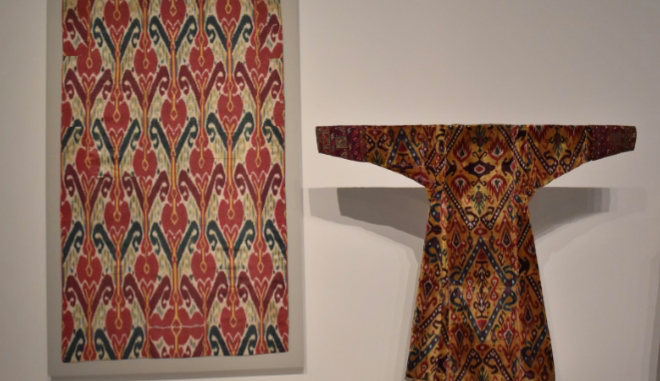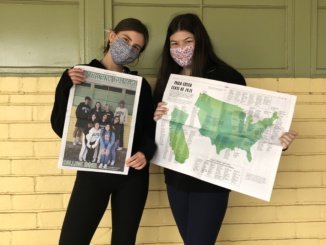
Clare Beezhold
Staff Writer
LACMA’s “Power of Pattern: Central Asian Ikats” gives viewers the opportunity to experience real life examples of Central Asian ikat textiles, which is a type of fabric that will help culminate a newfound appreciation for the design technique within them.
The “Power of Pattern: Central Asian Ikats” exhibit showcases more than 60 examples of visually captivating ikat robes and wall hangings. These one of a kind textiles are testament to the power of pattern, and are inspired by both nature and geometric shapes. Central Asia is a region that encompasses the countries of Kazakhstan, Kyrgyzstan, Tajikistan, Turkmenistan and Uzbekistan, all of whom are nestled between present-day Iran, Afghanistan, India, China, Mongolia and Russia. Central Asia was once a center of trade and conquest for thousands of years and its’ ikat textiles are rich with patterns that are influenced by the various cultures that traveled through or settled along the historic Silk Road.
The luxurious ikat textiles in this exhibit reflect not only the wealth and sophistication of their patrons, but also provide the viewer with a kaleidoscopic display of contrasting hues and patterns. The pieces on display are prime examples of how during the 19th and early 20th centuries, Central Asia experienced a renaissance in Ikat. Each of the vividly patterned robes and wall hangings on display are drawn solely from the collection of David and Elizabeth Reisbord. Organized by motif, the exhibit examines how ikat designers, dyers and weavers used improvisation and abstraction to create textiles unique to Central Asia.
The patterns achieved by ikat came from a technique in which silk threads were bound and resist-dyed with a design before weaving the cloth. The result is a vivid pattern with blurred, “cloud-like” designs known locally as abrbandi (literally meaning “cloud binding”). Central Asian artisans historically used zoomorphic imagery to represent virtues of vitality and power, such as snakes, ram horns, and bird beaks or claws. Similarly, vegetation was also used to symbolize the cyclical nature of life, death and rebirth oftentimes by featuring the tree of life with its’ roots in the underworld and branches reaching toward heaven. These different uses of imagery are noticeable in the exhibit and tells a beautiful and colorful story to the viewer.
Included in the exhibit are several fine examples of T-shaped robes called chapan which were a staple garment in Central Asia. The chapan, which was worn over a tunic or dress and trousers, descended from the clothing of ancient nomadic horsemen. The richness of the textile revealed the wealth of the wearer with the robes on display, illustrating the art of even the simplest of pieces. These robes are dusted with beautiful and intricate patterns that will leave the viewer in awe.
Also on display in the exhibit are several stunning ikat wall hangings which are called pardah (Persian for “curtain” or “veil”). Ikat wall hangings were used extensively throughout Central Asia to decorate interiors, cover doors or windows, and separate spaces in homes. Made of lengths of fabric, designs typically were not aligned at the seams, an aesthetic that not only prevented fabric waste, but also further heightened the visual liveliness of the patterns. These textiles displayed alluring patterns assuring the viewer of the time and craftsmanship that went into making these pieces.
One of the women’s robes on display features multicolored branched shapes reminiscent of ram horns interspersed with a variety of smaller motifs in an all-silk ikat velvet called baghmal. The textile of this specific robe was extraordinarily difficult to create because the luxurious cut pile, rather than loop pile, required much longer ikat silk wraps than what was customary in flat-woven ikats. An additional Turkmen silk-embroidered cuff also heightens the splendor of this robe, which was likely for a very affluent woman. The piece has an essence of luxury and beauty beyond compare. Standing in front of this particular robe one cannot help but be mesmerized by the lush and velvet quality of this piece. It is hard to resist the impulse to reach out and stroke this exquisite example of a long ago Central Asian artisan’s handiwork.
Also on view is an ikat wall hanging that perfectly displays the concept of flora and fauna that the Central Asian artists employed. This paradah comes from Bukhara, Uzbekistan from the second half of the 19th century. It is cut from smooth silk and cotton and is one of the plain weaves with an ikat warp. The wall hanging uses vivacious colors and a unique pattern to draw the viewer in.
After taking in these fabric masterpieces viewers have a newfound appreciation for the works that have come out of central Asia in terms of their textiles historically. If viewers are looking for colorful and extraordinary inspiration for their wardrobe, this exhibit would be worth the trip to the mid-cities district.
2“Power of Pattern: Central Asian Ikats” is currently on exhibit at LACMA Feb. 3 through July 28. For more information regarding this and future exhibits, visit www.lacma.org





Leave a Reply